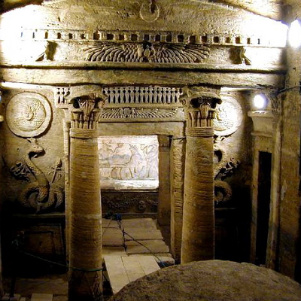Catacombs of Kom el-Shuqafa

The catacombs of Kom el-Shuqafa date to the early Roman period (c.a. 2nd century CE). Thought to have originally been a large private tomb for one wealthy individual and relatives (probably Roman or Greek), Kom el-Shuqafa was later converted into a public necropolis, housing the bodies of several different social groups. Architecturally what is most significant about the catacombs is the wall art. Depicted throughout the tomb are scenes that incorporate both Greco-Roman design and traditional Pharonic Egyptian symbols of the afterlife/funerary customs. It is interesting, though, to note that, while representations of both cultures are present, a sure sign of each's prevalence in the multi-cultural cosmopolitan world of Alexandria, they are usually separated in the art of the catacombs, presented more as parallel images than as one blended one.
